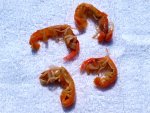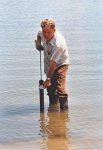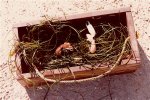Ghost Shrimp. Three species of ghost shrimp are found in California and collectively they represent what may be the best inshore bait in California.
The most common species is the bay ghost shrimp, Neotrypaea californiensis (formerly Callianassa californiensis). Other names include the red ghost shrimp, pink mud shrimp, and simply ghost shrimp. It is soft-bodied with a translucent white coloring in which its internal organs (pink, orange, or yellow in color) are visible and give the shrimp an overall pink-and-white coloring. The claws are unequal with one greatly enlarged. It reaches 4.8 inches in size. Its range is from Bahía de San Quintin, Baja California, Mexico to Mutiny Bay, Alaska. It is found in the sand and sandy mud of marine sloughs and bays throughout the state. Burrows can extend down 18 inches.
A second species is the giant ghost shrimp, Neotrypaea gigas (formerly Callianassa gigas). Other names include long-handed ghost shrimp. It is white, cream-colored or almost yellowish in some specimens. Large males are easily distinguished from the bay ghost shrimp by its very long, larger claw, a claw that can be longer than its body. Females and juveniles lack the long claw and can be difficult to distinguish from the bay ghost shrimp. It reaches 5.9 inches in length. They range from Bahía de San Quintin, Baja California, Mexico to Digby Island, British Columbia. Found in the low intertidal zone, typically lower than the bay ghost shrimp but the species may overlap. Burrows usually only extend down about 10 inches.
Southern California is the main residence of the third species, the smaller, tidepool ghost shrimp, Neotrypaea biffari (formerly Callianassa affinis). It has a somewhat crayfish-like appearance with a similar translucent white coloring. It is distinguished by its eyestalks, which have round tips. It reaches 2.6 inches in length. They range from Bahía Tortugas, Baja California, Mexico to Cayucos, California. It is found only in the intertidal zone of protected beaches that have a boulder-covered shore; it builds permanent burrows in sandy gravel between and beneath the boulders. Most burrows are also inhabited by blind gobies, Typhlogobius californiensis.

All three species are simply called ghost shrimp in bait shops and all three make excellent bait. In fact, when used live, they are often the best bait, especially in bays.
In southern California’s bays, ghost shrimp will mainly entice croaker (spotfin, yellowfin and black), bass (spotted bay bass, sand bass and kelp bass), an occasional flatfish (including halibut), sharks and rays. Larger perch, mainly rubberlip, blackperch and white seaperch will also hit the shrimp.
In San Francisco Bay they will entice the larger perch, are good for starry flounder (if you can find them), are excellent for sturgeon and will also entice an occasional striped bass to hit. Although not the best bait, it will also tempt sharks and bat rays.
On southern California beaches, ghosties yield barred surfperch, California corbina, yellowfin croaker, spotfin croaker, sharks and rays. On central California beaches they typically entice barred surfperch and calico surfperch, although striped bass are also known to grab a ghostie or two. In northern California ghost shrimp are gobbled up by redtail surfperch, cabezon, and rockfish.
At Catalina, while fishing from Avalon’s two piers, large ghost shrimp have proven to be one of the best baits for sheephead while small to medium-size ghost shrimp are excellent opaleye bait.
Although there may be nothing like a true juju bait, ghost shrimp will sometimes yield fish when nothing else will work. Several times I have been the only fisherman catching fish simply because I was the only one using ghost shrimp, and it happened in as diverse locations as San Diego, Ventura, Pismo Beach, Bodega Bay and Point Arena. I also was on the opposite end of the spectrum once when I went nearly fishless on the Shelter Island Pier in San Diego Bay while a nearby angler (the only angler with ghost shrimp) pulled in what seemed like an unending string of sand bass and yellowfin croakers, one right after another.
Unfortunately, ghost shrimp can sometimes be difficult to find today, at least as far as in bait shops. They are available in a few bait shops around San Diego Bay, a few shops in beach areas of L.A. (where they are sometimes called saltwater crawfish), and in most shops in the San Francisco Bay Area and Delta. I have never seen them in shops north of the Bay Area. Most of the ghost shrimp sold in Bay Area stores are imported from Washington state.
However, they are readily available in most bays and along some beaches. All you need is a ghost shrimp pump, a device that looks like a long tube with a handle. These are basically hand suction pumps and are sold at many bait and tackle stores. You can also make your own pumper. See the instructions on making a pumper. The Internet and YouTube also show how to make a pumper. The pump is used in the sand/mud near the water’s edge in ghost shrimp areas (the wet zones of sand and mud flats that are exposed at low tide) and, hopefully, ghost shrimp are soon being sucked/pumped out of their burrows.

My dad pumping ghost shrimp in Mission bay
Low tide or a still low, incoming tide, seem to be the best times. Look for holes in the mud that look like miniature volcanoes, especially ones that seem to have wet sand around the openings. These these are the openings to ghost shrimp burrows. The pump is placed over the hole and the handle is simply pulled up. Sand/mud and hopefully some ghost shrimp are sucked up into the pump. When the handle is pushed back down the sand/mud/shrimp are expelled. Be ready to grab the shrimp for your bucket.
Once you learn the best areas and proper technique it is not uncommon to pump 50 shrimp in less than half an hour. They will live throughout the day if kept cool and can live in a cool bucket or the refrigerator overnight for a couple of days. When I am on my fishing trips I keep ice in my small bait cooler at all times and have had ghost shrimp live for about 3-4 days (but do not let the shrimp sit directly on the ice). Although I have tried various ways to keep them frozen, I haven’t had success; upon thawing out they are simply too soft to cast (although the pieces make an effective chum). As for as the “prepared” ghost shrimp you see in stores, I have had absolutely no success with the bait, I consider it a waste on money. However, given that the bait remains in the bait shops, someone must be able to use it.

Years ago, before pumps were so common, a popular method was to watch for the tell-tale signs of their burrow and then “stomp” the burrow closed. This would force the ghost shrimp to the surface where they could easily be captured by hand or shovel. Advocates of this approach say that there was less damage to the shrimp than in using pumps, and that the bait would stay alive much longer. They could be right although today if you saw a bunch of guys out “stomping around” on a mud flat you just might be inclined to call the guys in the white coats. Of course it could be some over-aged, Berkeley-Mendocino, ex-Hippy, now-mainstream businessmen doing their male bonding ritual. And, afterall, that's still more appealing than a bunch of hairy guys standing in a circle under old-growth redwoods, adorned only with chaplets on their heads (naked as jaybirds). But that's another story.
Ghost shrimp, by the way, can also be found near the mouths and estuary areas of north country streams. I used to pump them up in the tidal water areas of the Albion River and Little River in Mendocino County. I used them when fishing the coastal areas between Mendocino and Point Arena. They are also considered a premier bait for steelhead. I’ve seen them used by a couple of anglers in Mendocino County and further north, in Oregon and Washington, they are wildly used. In those areas they are commonly called “sand shrimp.”
(California limit on ghost shrimp: Ghost Shrimp and Blue Mud Shrimp — 50 in combination of species.)

I like to use the long-shanked Kahle hooks but most long-shanked hooks (even worm hooks) will work. The size of the hook depends to a degree on the size of the shrimp you’ve pumped; I’ve used everything from a size 8 Kahle hook for very small shrimp to 2/0 for large ghost shrimp. For smaller fish, a small piece of ghost shrimp will also work.
The hooks can be used on either high/low riggings or on Carolina-type leaders (sliding sinker, bead, swivel, about two feet of leader (fluorocarbon preferred), and the hook. Do check to make sure the Kahle hook is sharp, for some reason they often do not seem to arrive as sharp as other hooks.
The most common species is the bay ghost shrimp, Neotrypaea californiensis (formerly Callianassa californiensis). Other names include the red ghost shrimp, pink mud shrimp, and simply ghost shrimp. It is soft-bodied with a translucent white coloring in which its internal organs (pink, orange, or yellow in color) are visible and give the shrimp an overall pink-and-white coloring. The claws are unequal with one greatly enlarged. It reaches 4.8 inches in size. Its range is from Bahía de San Quintin, Baja California, Mexico to Mutiny Bay, Alaska. It is found in the sand and sandy mud of marine sloughs and bays throughout the state. Burrows can extend down 18 inches.
A second species is the giant ghost shrimp, Neotrypaea gigas (formerly Callianassa gigas). Other names include long-handed ghost shrimp. It is white, cream-colored or almost yellowish in some specimens. Large males are easily distinguished from the bay ghost shrimp by its very long, larger claw, a claw that can be longer than its body. Females and juveniles lack the long claw and can be difficult to distinguish from the bay ghost shrimp. It reaches 5.9 inches in length. They range from Bahía de San Quintin, Baja California, Mexico to Digby Island, British Columbia. Found in the low intertidal zone, typically lower than the bay ghost shrimp but the species may overlap. Burrows usually only extend down about 10 inches.
Southern California is the main residence of the third species, the smaller, tidepool ghost shrimp, Neotrypaea biffari (formerly Callianassa affinis). It has a somewhat crayfish-like appearance with a similar translucent white coloring. It is distinguished by its eyestalks, which have round tips. It reaches 2.6 inches in length. They range from Bahía Tortugas, Baja California, Mexico to Cayucos, California. It is found only in the intertidal zone of protected beaches that have a boulder-covered shore; it builds permanent burrows in sandy gravel between and beneath the boulders. Most burrows are also inhabited by blind gobies, Typhlogobius californiensis.

Ghost Shrimp
All three species are simply called ghost shrimp in bait shops and all three make excellent bait. In fact, when used live, they are often the best bait, especially in bays.
In southern California’s bays, ghost shrimp will mainly entice croaker (spotfin, yellowfin and black), bass (spotted bay bass, sand bass and kelp bass), an occasional flatfish (including halibut), sharks and rays. Larger perch, mainly rubberlip, blackperch and white seaperch will also hit the shrimp.
In San Francisco Bay they will entice the larger perch, are good for starry flounder (if you can find them), are excellent for sturgeon and will also entice an occasional striped bass to hit. Although not the best bait, it will also tempt sharks and bat rays.
On southern California beaches, ghosties yield barred surfperch, California corbina, yellowfin croaker, spotfin croaker, sharks and rays. On central California beaches they typically entice barred surfperch and calico surfperch, although striped bass are also known to grab a ghostie or two. In northern California ghost shrimp are gobbled up by redtail surfperch, cabezon, and rockfish.
At Catalina, while fishing from Avalon’s two piers, large ghost shrimp have proven to be one of the best baits for sheephead while small to medium-size ghost shrimp are excellent opaleye bait.
Although there may be nothing like a true juju bait, ghost shrimp will sometimes yield fish when nothing else will work. Several times I have been the only fisherman catching fish simply because I was the only one using ghost shrimp, and it happened in as diverse locations as San Diego, Ventura, Pismo Beach, Bodega Bay and Point Arena. I also was on the opposite end of the spectrum once when I went nearly fishless on the Shelter Island Pier in San Diego Bay while a nearby angler (the only angler with ghost shrimp) pulled in what seemed like an unending string of sand bass and yellowfin croakers, one right after another.
Unfortunately, ghost shrimp can sometimes be difficult to find today, at least as far as in bait shops. They are available in a few bait shops around San Diego Bay, a few shops in beach areas of L.A. (where they are sometimes called saltwater crawfish), and in most shops in the San Francisco Bay Area and Delta. I have never seen them in shops north of the Bay Area. Most of the ghost shrimp sold in Bay Area stores are imported from Washington state.
However, they are readily available in most bays and along some beaches. All you need is a ghost shrimp pump, a device that looks like a long tube with a handle. These are basically hand suction pumps and are sold at many bait and tackle stores. You can also make your own pumper. See the instructions on making a pumper. The Internet and YouTube also show how to make a pumper. The pump is used in the sand/mud near the water’s edge in ghost shrimp areas (the wet zones of sand and mud flats that are exposed at low tide) and, hopefully, ghost shrimp are soon being sucked/pumped out of their burrows.

My dad pumping ghost shrimp in Mission bay
Low tide or a still low, incoming tide, seem to be the best times. Look for holes in the mud that look like miniature volcanoes, especially ones that seem to have wet sand around the openings. These these are the openings to ghost shrimp burrows. The pump is placed over the hole and the handle is simply pulled up. Sand/mud and hopefully some ghost shrimp are sucked up into the pump. When the handle is pushed back down the sand/mud/shrimp are expelled. Be ready to grab the shrimp for your bucket.
Once you learn the best areas and proper technique it is not uncommon to pump 50 shrimp in less than half an hour. They will live throughout the day if kept cool and can live in a cool bucket or the refrigerator overnight for a couple of days. When I am on my fishing trips I keep ice in my small bait cooler at all times and have had ghost shrimp live for about 3-4 days (but do not let the shrimp sit directly on the ice). Although I have tried various ways to keep them frozen, I haven’t had success; upon thawing out they are simply too soft to cast (although the pieces make an effective chum). As for as the “prepared” ghost shrimp you see in stores, I have had absolutely no success with the bait, I consider it a waste on money. However, given that the bait remains in the bait shops, someone must be able to use it.

"Making bait"
Years ago, before pumps were so common, a popular method was to watch for the tell-tale signs of their burrow and then “stomp” the burrow closed. This would force the ghost shrimp to the surface where they could easily be captured by hand or shovel. Advocates of this approach say that there was less damage to the shrimp than in using pumps, and that the bait would stay alive much longer. They could be right although today if you saw a bunch of guys out “stomping around” on a mud flat you just might be inclined to call the guys in the white coats. Of course it could be some over-aged, Berkeley-Mendocino, ex-Hippy, now-mainstream businessmen doing their male bonding ritual. And, afterall, that's still more appealing than a bunch of hairy guys standing in a circle under old-growth redwoods, adorned only with chaplets on their heads (naked as jaybirds). But that's another story.
Ghost shrimp, by the way, can also be found near the mouths and estuary areas of north country streams. I used to pump them up in the tidal water areas of the Albion River and Little River in Mendocino County. I used them when fishing the coastal areas between Mendocino and Point Arena. They are also considered a premier bait for steelhead. I’ve seen them used by a couple of anglers in Mendocino County and further north, in Oregon and Washington, they are wildly used. In those areas they are commonly called “sand shrimp.”
(California limit on ghost shrimp: Ghost Shrimp and Blue Mud Shrimp — 50 in combination of species.)

My daughter Kim helping her granddad pump some ghost shrimp in Mission Bay
Hooking the shrimp is easy but done incorrectly the fragile shrimp can fly off on the cast. In most cases you should simply string an entire ghost shrimp onto your hook. Turn the ghost shrimp on its back, insert the hook into the underside of the tail, push the hook through the body, and exit the hook below the head. Some anglers will wrap them with thread to keep them on the hook but I’ve never found that necessary.
I like to use the long-shanked Kahle hooks but most long-shanked hooks (even worm hooks) will work. The size of the hook depends to a degree on the size of the shrimp you’ve pumped; I’ve used everything from a size 8 Kahle hook for very small shrimp to 2/0 for large ghost shrimp. For smaller fish, a small piece of ghost shrimp will also work.
The hooks can be used on either high/low riggings or on Carolina-type leaders (sliding sinker, bead, swivel, about two feet of leader (fluorocarbon preferred), and the hook. Do check to make sure the Kahle hook is sharp, for some reason they often do not seem to arrive as sharp as other hooks.
